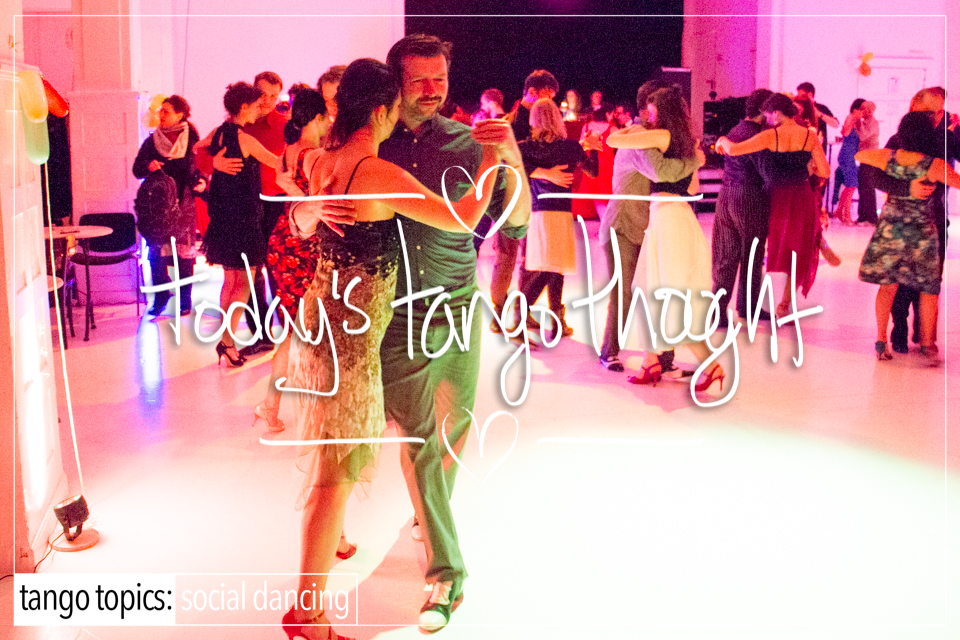Bashing ? Meaning that you’re throwin’ some shade, picking on, pointing out the errors of, giving some shit, pointing fingers at, trash talking, talk down, blaming and shaming, and the euphemistic UK’ism “taking the piss”. While that last one is more about making fun of someone, that’s not actually what this idea is all about. It’s about disparaging someone, or in this case, from a Tango perspective, the L/lead’s abilities (the person, and the action).
Before we roll into this one, let’s be clear about a few things: The L/lead is responsible for a lot of what happens in the course of a dance, and the tanda. They are responsible for:
1.) The structure of a dance (embrace, posture, etc). 2.) The architecture of a dance (how things look). 3.) The musical interpretation of a dance. 4.) The management of the Follower. 5.) Their line of dance. 6.) Their lane of dance. 7.) Vocabulary choices (Ochos, Turns, Crosses, Sacadas, etc). 8.) Floorcraft. The execution of vocabulary within their line and lane of dance. 9.) Proper Cabeceo, and inviting the Follower for a tanda. 10.) The Salida. Just to name a few…. 😉
That’s a lot for someone to handle. A small portion of leads do about 70% of that stuff exceptionally well. And if you think you’re in that category then you have an ego the size of Montana. It’s more likely about 40% of Leads do some of that stuff, but not in all of them, and they ignore the rest. 3 of those things come up frequently for most as areas of concern or focus: Floocraft, Musical Interpretation, and Vocabulary Execution. And in specific the ‘sloppiness’ therein. Sloppiness ? Meaning the off-timed execution of such without care of awareness (more lack of awareness) of the detailed precision that is required even in Social Tango. However, most if not all a lead’s (the action) problems exist in within the embrace!
Leads are sensitive, just as Followers are, it’s just that Follower’s get all the blame for X, Y, and Z when in fact it’s the Lead that should get 90% of that blame. You may disagree with that until you ask one simple question: “If the Lead led X, Y, and Z, what on earth is the Follower apologizing for ?”. Which is to say that the only thing that a Follower should be apologizing for is poorly executing (that’s your technique) what was led, and that’s about it. One could argue that being lethargic, or lethargy is something to apologize for, being late as it were. However, if we are speaking in terms of the Passive Follower, then everything, everything else, belongs to the lead through the course of a dance. If we’re speaking of the Role of the Active Follower, then things are slightly different in this regard. Because the statement who owns what in the dance doesn’t hold true once the Follower starts to become aware of their options and opportunities, thereby becoming an Active Follower. But that’s not what this post is about, and those are two very different Followers to be discussed later on.
You’re going to think that the list of places where a Lead can screw up, which is by no means a comprehensive list, is L/lead Bashing. They’re not. These are the more common areas that create more problems than they’re worth: 1.) Left Arm. It’s either too stiff, too compressive, too resistive, too high above the shoulder line of the follower. 2.) Left hand. They squeeze too much, their hand is out like a waiter. 3.) Right forearm. Too compressive (squeezing too much), Too low (tsk, tsk, tsk), Too high (wtf is that about ?). 4.) Right bicep. Too compressive. 5.) Head Tilt into or away from the Follower, usually into which creates head pressure and pain. 6.) Armpit Leading. Meaning to place the Follower in their armpit because it’s ‘comfortable’ for the Lead. 7.) The pseudo unclear embrace distance. Are we in close embrace ? Are we not ? WTF is that ? 8.) Landing on the 5th Metatarsal (baby toe) and wobbling. 9.) Repetitive vocabulary choices. Over and over and over again. 10.) The Unused ‘Mordida’. 11.) Watching the Follower’s feet (co-combines with #5). 12.) The Lazy Man’s Turn! 13.) The Forced Volcada! 14.) Unable to follow or maintain their line of dance, their lane of dance, or the distance between the couples. 15.) Unaware of their vocabulary choices and how it is affecting the entire line and lane of dance that they’re in. Just to identify a few.
Is this Lead Bashing ? No. It’s stating what actually happens.
So what is Lead Bashing ? Something akin to “That guy over there, he can barely walk, on the beat, to the pauses. Look at that. He’s squeezing the living daylights out of his Follower. And will you look at that technique! Jesus. Who the frak taught that guy to walk! Another volcada, seriously ?” … etc. This is disparaging of the L/lead. The issue on the table isn’t that it happens, it most certainly does. People are very judgmental about what they see from Leads, which speaks to the fact that the Lead has enormous amount of responsibility (even in today’s Tango world). No. This is really about the volume of information that most Leads fail at and quite literally ignore, because of ignorance, or ego. And if it’s the latter point they deserve all the judgement that people heap on them. It’s the Lead that is trying to change that on a regular basis (read that as daily solo practice) that does not need or deserve that disparagement or Lead Bashing. (see also Follower Bashing)











